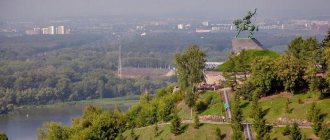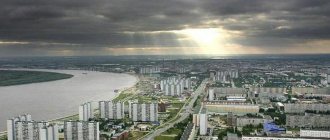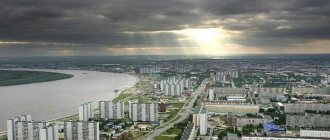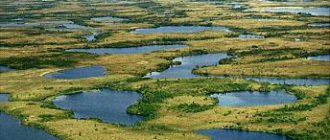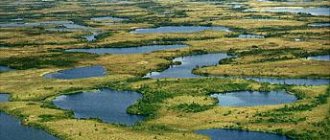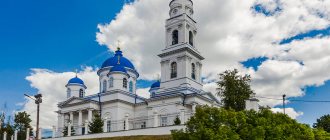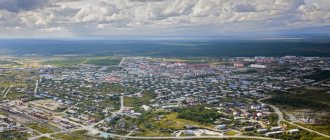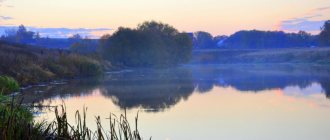66°3200 is the latitude where Salekhard is located, the region of the Arctic Circle and the capital of the Yamalo-Nenets Autonomous Okrug. It is unique in that it is the only city in the world built on this parallel.
This geographical location characterizes special climatic conditions: snow can lie here for up to two hundred days a year, and frosts can reach up to 50 degrees Celsius. There are no polar nights, when the sun does not appear at all, but the so-called twilight nights last 159 days. Here you can observe an amazing natural phenomenon - the Northern Lights. The polar day lasts from 7.06 to 7.07. Summer can be both very hot - up to 30 degrees and above, and cool - up to 5-10 degrees. Salekhard is also famous for the fact that there is a beach, south of which all the beaches in the world are located.
Salekhard is the capital of Yamal
According to archaeologists, in the place where the capital of the Yamalo-Nenets Autonomous Okrug is now located, people built settlements over two thousand years ago.
Subsequently, near the mouth of the Poluy River, which flows into the Ob, the Cossacks, during the development of the Arctic, built the Obdorsky fort, which gradually turned into a fortified city - one of many in northern Siberia.
In 1595, Obdorsk was founded on the site of the fort, which two centuries later became the volost center of the Tobolsk province.
Residents hunted and fished and were engaged in trade: for 30 houses there were one and a half hundred trading shops. At the beginning of winter, the Obdorsk Winter Fair was held here, where furs, mammoth ivory, fish and bird feathers were exchanged for flour, cloth, tobacco and alcohol, which was brought here by hundreds of merchants.
In 1933, when Obdorsk became the capital of the Yamal-Nenets Autonomous Okrug, it was renamed Salekhard, which from Nenets means “Village (in Nenets language - “sele”) on a cape (in Nenets language - “hard”).”
It is the center of the Yamalo-Nenets Autonomous Okrug.
2. The peculiarity of the geographical location of Salekhard is such that the city is located at the 66th parallel of the northern hemisphere, right on the Arctic Circle of our planet.
STELE “ARCIC CIRCLE” IN SALEKHARD
3. By the way, Salekhard is the only city in the whole world located not beyond the Arctic Circle, but right on it. In honor of this, a special monument was erected here.
4. The city is surrounded on all sides by endless tundra and forest-tundra, which amazes tourists with its untouched nature.
5. Salekhard is connected by ferry across the Ob River (in summer) and ice crossing (in winter) with the Labytnangi railway station.
6. Salekhard was founded by the Cossacks more than 400 years ago. Initially, there was the Obdorsk fortress, which played the role of the northernmost fort.
SHEMANOVSKY MUSEUM
7. Once upon a time, in the place where Salekhard is located today, there was a mammoth camp. The remains of one of them are still kept in the Shemanovsky Museum. You can also see a stuffed musk ox there.
8. Salekhard is an interesting but harsh place. The northern climate, coupled with the wildlife that surrounds it, makes life here challenging.
9. The lowest temperature ever recorded in Salekhard was -53.7 degrees, and the highest was +32.9.
10. There is snow here for up to 200 days a year, which makes Salekhard’s climate one of the harshest among all Russian cities.
11. There is no polar night in Salekhard, but the polar day, when the Sun does not fall below the horizon, lasts about 31 days.
12. Until 1933, the city of Salekhard was called Obdorsk.
13. Salekhard is the capital of Yamal. This is despite the fact that there are much larger cities in the district, for example, Novy Urengoy or Noyabrsk.
14. In winter in Salekhard you can see the amazingly beautiful northern lights.
15. The main event of spring is a bright ethnographic holiday of indigenous peoples (Khanty, Nenets, Selkup, Zyryans) - Reindeer Herder's Day.
16. In the summer in Salekhard there is a polar day, the tundra abounds in berries and mushrooms,
ICE SCULPTURE AT THE POLAR RHAPSODY FESTIVAL
17.And in the fall, the Obdorsk Fair and the Polar Rhapsody ice sculpture festival are held here.
18. Professional revolutionary, 25-year-old Bogdan Knunyants, exiled to Salekhard (Obdorsk) in 1907, writes about his first impressions of the city: “Obdorsk pleasantly struck us at first sight. We did not expect that in such a distant North there could be such a beautiful and rich village. From a distance, 2 churches and a number of large, beautiful, purely urban buildings caught my eye. It would not be an exaggeration to say that there are houses there that would do honor to any provincial city in European Russia.”
19. Today one of the streets of Salekhard bears the name of Bogdan Knunyants.
A COPY OF THE OBDORSK FORTRESS IN SALEKHARD
20. Here you can see the Obdorsk Fortress. But this fortress is still a remake, and it has only been recreated in recent years. It's quite small.
21. In 1949-1953, Salekhard was one of the base points for the construction of the Transpolar Railway (mainly an inactive railway line to Novy Urengoy, also passing through Nadym).
22. Many memorial signs here are installed not in the city, but on its bypass road.
23Also located on the Salekhard bypass monument to the 501st construction site in the form of a steam locomotive with a semaphore. The locomotive, by the way, just participated in the construction of this highway.
CAL MAMMOTH LYUBA IN THE NATIONAL MUSEUM OF YNAO
24. A local attraction is the National Museum of the Yamal-Nenets Autonomous Okrug. It is well made and renovated. There are stands here about the history of the region, about its fauna, and there is a small exhibition dedicated to the 501st construction site.
25. Here they will tell a story about the mammoth Lyuba. Baby mammoth Lyuba went to the river, fell off a cliff and died as a child. Her body was carried away by the river, then the river froze, and so the frozen body, trapped in permafrost, has survived to this day almost without loss. It is a unique fact that the carcass of a real prehistoric animal was found in such good condition.
TEMPLE OF SAINT PETER AND PAUL
26. And within the boundaries of Salekhard itself there is the Church of St. Peter and Paul.
27. Despite the fact that the city has a long history, and has been the district capital for several decades, until recently its architecture was a rather dull and faded sight: the city was almost entirely built up with two- and one-story wooden barracks.
28. The global restructuring of Salekhard began only at the beginning of the 21st century.
29. Since the 2000s, massive demolition of old and dilapidated houses began, and modern, bright buildings began to be erected in their place - the appearance of the oil and gas capital should correspond to its status.
30. Today Salekhard boasts many modern new buildings. And fifty years ago, instead of glass in the windows, you could see stretched fish skin.
31. Salekhard is associated with such a famous historical figure as Grigory Rasputin. It was here that his son Dmitry died in 1933, working on the construction of a fish canning plant.
32. In a couple of hours from Salekhard you can reach the Polar Urals, where its harsh ridges lie. There you can go skiing, climb to glaciers and waterfalls.
33. There are no musk oxen in Salekhard. But not far from Salekhard, in the “Polar-Ural” natural park, about 120 of these amazing animals live.
34.Perhaps in the future a safari park will be opened here, where musk oxen can be seen in the wild. Today you can only appreciate the size of this beast in the Shemanovsky Museum - there is a stuffed adult musk ox here.
35. The action of Eduard Topol’s novel called “Red Gas” takes place in Salekhard.
NORTH FISH STROGANINA
36. In Salekhard you can try completely authentic dishes: stroganina and malosol from muksun. They taste in no way inferior to Japanese sushi.
37. The most popular shoes here are handmade burkas or beers.
38. The children of the nomadic peoples of Yamal have toys and rattles for children. Only they are made not from bright plastic, but from deer hooves. Such rattles are suspended over the baby's cradle and, when rocked, produce a dull, soothing sound.
39. One of the northernmost beaches in the world is located in Salekhard. It cannot be found in the lists of record holders, because it is not officially registered, but in the short and often hot summers, many townspeople relax on it.
40. In 1990, the capital of Yamal was included in the list of historical cities of Russia. This happened largely due to the fact that on the territory of the city there is an archaeological monument of world significance - the Ust-Poluy Settlement.
41. Of course, those coming to Salekhard need to be shown the national flavor. Small peoples, reindeer, plague, and so on Of course, it’s a long and far journey to get to real camps (or rather, you have to fly there by helicopter), and in the summer, reindeer herders generally go somewhere in the tundra, and can be anywhere. Therefore, there are several points around Salekhard where these deer with plagues are shown.
42. Until recently, to enter Salekhard, which is considered a border zone, a special pass was required. But now citizens of the Russian Federation do not require any documents other than a passport. Foreigners need a passport and a Russian visa.
43. Due to harsh conditions, nature in urban areas still remains largely untouched. For lovers of domestic tourism, this city is definitely worth adding to the list to visit.
44. Despite the harsh climate, Salekhard attracts many tourists with its unique attractions and picturesque nature.
45. Hotels in Salekhard are ready to open their doors to guests throughout the year.
photo from open sources
Geographical position
Geographic coordinates of Salekhard: 66 degrees and 32 minutes north latitude, 66 degrees and 37 minutes east longitude.
This is the latitude of the Arctic Circle. The capital of the Yamalo-Nenets Autonomous Okrug is practically divided by the sixty-sixth parallel into two parts. This geographical position of the city is unique and is marked by a memorial stele called the “Arctic Circle” or “66th Parallel”.
The total area of Salekhard is about 30 square kilometers. The city is located in the Tyumen region of the Ural Federal District, at an altitude of 15 meters above sea level, in the northern part of the West Siberian Plain.
The climate is sharply continental, characterized by particular severity: in January frosts can reach -50 °C, summer temperatures reach +30 °C. Summer is short, it lasts only 50 days.
When to go
As noted above, the city is located in the northern latitudes of the Russian Federation, and the main part of the year is dominated by such a natural phenomenon as twilight nights. However, travelers who are not afraid of bad weather and severe frosts can easily go on a long journey.
The concept of “best time to travel” is difficult to define. It all depends on the purpose and wishes of the tourists. Weather comparable to the middle latitudes of Russia prevails in the summer. In winter, vacationers can expect a thick cover of snow and severe frosts, all-terrain vehicle rides, and an exhibition of ice sculptures. However, regardless of the season, city guests will be able to get acquainted with the unique sights of the capital of the Yamal-Nenets Autonomous Okrug.
How time flows in Salekhard
There is no polar night in the capital of the Yamal-Nenets Autonomous Okrug, but there is another interesting feature that Salekhard has. Time. It flows in a special way. The proximity of the North Pole leaves its mark: when the polar day comes, night disappears in the usual sense.
The polar day lasts for a month: from June to July. At this time, the sun smoothly rolls in a circle above the horizon and does not fall completely beyond it for more than a day, so night does not replace daylight.
Such an unusual picture for the eye creates strange sensations: the body, tired during the day, requires rest, and the mind, not accustomed to giving the command to rest in full light, insists on continuing any action.
An interesting “night” illumination on such days without night appears to the eyes of residents and guests of Salekhard: the sun freezes low, low above the clear horizon, and a bright orange saturated light spreads around for several hours - a real gift for photographers: for interesting photographs with the play of chiaroscuro there is no you have to watch for a long time the short minutes of sunsets and sunrises.
GMT+5 is the time zone in which Salekhard lives. The time is 2 hours ahead of Moscow.
Heraldry of Salekhard
The official coat of arms of Salekhard is laconic, restrained, and strict. It is based on a French shield common to heraldry. The only symbolic image on the shield is a fox walking with its tail raised up and scarlet eyes; A scarlet tongue peeks out of its mouth.
The color scheme of the coat of arms is as strict as the image itself. Only three colors are used:
- Silver: the background of the shield, the shirtfront on the fox’s chest, its belly, the tips of its paws and tail.
- Black: fox.
- Scarlet (red): tongue and eyes.
The history of the existence of the heraldic sign dates back to 1731, when the coat of arms was granted to Obdorsk by Empress Anna Ioanovna. The image of the fox repeated the symbolism and color scheme of the historical symbol of the Siberian Principality of Obdorsk in the 17th century, with the only difference: in the historical version, the fox held an arrow in its paws.
The image of a fox as a symbol was not chosen by chance: this predatory animal, the silver fox, symbolizes the main occupation of the indigenous peoples of the Urals - hunting.
Administration
Salekhard has always been not only an independent administrative unit, but also a control center.
The administration of Salekhard unites many structural divisions whose activities are aimed at managing waterways and shipping, hunting management, fuel and energy and agro-industrial complexes of the Yamal-Nenets Autonomous Okrug.
Many well-known enterprises and companies operate in the capital of the Yamal-Nenets Autonomous Okrug:
- River port;
- fish canning plant;
- bakery;
- motor transport enterprise;
- railway and air transport companies;
- representative offices of gold mining, gas and oil producing companies, including Gazprom and Lukoil - Western Siberia.
The administration of Salekhard also resolves issues of social and economic development of the city.
In 2009, an administrative complex was built specifically to house the administration on the banks of the Shaitanka River.
sunken road
There were Gulag concentration camps in Salekhard, as throughout Siberia. Prisoners built factories, canals, and piers. More than 60 thousand people laid a railway in the permafrost of the tundra from Salekhard to Igarka. But the design did not take into account the features of the landscape, which resulted in subsidence of the embankments, erosion of the slopes, and absorption of rails and sleepers by the swamp. In 1954, the construction site was closed and the unfinished railway was written off. Steam locomotives, carriages, tractors, and tons of metal remained in the tundra.
Population of Salekhard
The Russian population began to appear in Obdorsk at the beginning of the 19th century. In 1897, 500 people lived here, who were engaged in fur-bearing animal hunting, fishing and trade.
At the end of the 20th century, when the massive development of the lands of Yamal began, the population of the capital of the Yamal-Nenets Autonomous Okrug began to grow at a rapid pace. Today Salekhard has a population of 45 thousand people.
People come here to work on gas and oil rigs. Scientists, teachers, doctors are coming. Not only a good “northern” salary, but also the romance of the Arctic Circle attracts many to Salekhard. The population of indigenous origin is the Khanty and Nenets, or Samoyeds. These are surprisingly taciturn and modest people with a traditional way of life, an original culture, interesting customs, rituals, and beliefs.
Many tribes continue to live in the tundra and, like their ancestors, engage in fishing, hunting, reindeer herding, and believe in spirits. They roam from pasture to pasture with herds of thousands of deer.
They live in tents, built, as many centuries ago, from long poles and reindeer skins. From the age of four, boys can use a lasso and drive sledges, girls can light a fire in a tent and sew national clothes.
Trading village
Obdorsk from an outpost becomes a village. Relations with the indigenous inhabitants (Komi, Nenets, Khanty, Mansi) were initially friendly, trade relations developed, which turned into an annual winter fair, the popularity of which was evidenced by the constant increase in its turnover. The fair, where Salekhard is located, attracted not only Siberian merchants, but also traders from the European part of the country, who noted the special flavor of the fair: hundreds of deer harnessed to sledges, next to them were traders dressed in reindeer skins. Merchants brought food, fabrics, jewelry, and purchased valuable furs from fur-bearing animals and fish.
Architectural appearance of the city
The ancient city of Salekhard has changed a lot since the days of the Obdorsky fort. Today it has a modern architectural appearance. Intensive housing development and construction of new social infrastructure buildings are underway. After renovation, old houses were given a look that corresponds to the general architectural style. Multi-storey buildings look like a multi-colored palette against the backdrop of a cloudy day or white snow. They are painted in rich, bright, picturesque colors: cherry and blue roofs, green, blue, orange, yellow walls - the color scheme fills the harsh northern city with a special warmth and creates coziness.
Many architectural objects are unusual. One of the memorable structures is the “Torch” cable-stayed bridge with a single pylon. There is a restaurant here, right above the water surface of the Shaitanka River.
The capital of the Yamalo-Nenets Autonomous Okrug is peaceful towards all religions. This is evidenced by the fact that on the territory of the city there are adjacent Orthodox churches and a mosque, which is located closest to the Arctic Circle than any other mosque in Russia.
Next to it, the construction of the Transfiguration Cathedral is underway.
The first stone church in Salekhard is the Peter and Paul Cathedral, built in 1894. Snow-white walls, light blue towers, golden domes with crosses - under the low polar sky against the backdrop of endless tundra and the river, the building seems airy, directed upward.
Museum and exhibition complex
At the end of the 16th century, Russian Cossacks crossed the Urals and built the Obdorsk fortress on the right bank of the large river. The name was chosen simply: “ob” - along the Ob River, and the Komi word “dor” means “shore”.
Over time, the wooden fortifications were overgrown with huts, outbuildings, and turned into the village of Obdorsk. It became the center of the Obdorsk volost of the Berezovsky district. Yes, yes – the very same Berezov, where Peter I’s associate Alexander Menshikov ended his days in exile.
In 1807, the old fortress was demolished as unnecessary. When its right tributary, the Poluy River, flows into the Ob, only an overgrown village remains.
A hundred years later, abbot Irinarh, in the world Ivan Semenovich Shemanovsky, began to collect extensive collections on ethnography. They were dedicated to the history and traditions of the indigenous peoples of the Tobolsk North. Shemanovsky served as rector of the church in Obdorsk until 1910, and then was transferred to Turkestan.
When the revolution happened, he renounced his rank and became a journalist. The time of Shemanovsky's death is not clearly indicated. It is believed that he died in 1922-1923 in Turkestan, during the civil war.
On June 20, 1933, Obdorsk changed its name and became Salekhard. In Nenets, “sale-hard” means “settlement on a cape.” Five years later it received city status. At that time, just over 12 thousand people lived here.
Despite all the cataclysms of history, fires, Shemanovsky’s unique collections did not perish and formed the basis of the city museum. Today, a large museum and exhibition complex bears the name of I. S. Shemanovsky. This is the place where all tourists try to get. The spacious halls contain many items that date back to the historical and prehistoric eras of human exploration of Western Siberia.
The fact that people lived in the lower reaches of the Ob long before the construction of Obdorsk has been known for a long time. The museum's collections contain the mummy of a warrior who was buried in 1282. In one of the halls there is a sculpture made of deer antler, carved in the 1st century BC.
Fragments of mammoth skeletons and tusks discovered near Salekhard are very popular among tourists. One of the glass display cases is occupied by the baby mammoth “Lyuba”. A perfectly preserved mummy was found in 2007 in the Yuribey River valley. Visitors spend a long time near the entire skeleton of a huge mammoth, whose age exceeds 17 thousand years.
The Salekhard museum has many unique exhibits, for example, an elegant dress woven by the Khanty from nettle fibers. It is very interesting to study the letters of the Obdorsk government of the 17th-18th centuries and look at the parka of a Selkup shaman with pendants from the 19th century.
The museum halls contain documentary evidence about the notorious Chum-Salekhard-Igarka railway. Tens of thousands of prisoners died during the construction of this northern highway. There is a lot of information about different periods of the history of Salekhard. They are well organized, illustrated with old photographs and paintings by local artists.
The museum doors are open every day except Monday. It welcomes visitors from Tuesday to Thursday from 10:00 to 19:00, on Fridays from 12:00 to 20:00, and on Saturday and Sunday from 11:00 to 18:00.
The sculptural world of Salekhard
The sculptural world of Salekhard is unusual. There are a large number of monuments dedicated to animals that embody the sacred spirits of the indigenous inhabitants of Yamal:
- Near the ferry crossing there is a 10-meter mammoth. More than 40 extinct mammoths have been found in northern Siberia, among them the Yamal mammoths Masha and Lyuba.
- On the embankment of the Shaitanka River there is a six-meter monument to the reindeer - the main wealth of the tundra, a symbol of goodness and immortality.
- The bypass road is crowned with a sculptural composition dedicated to the Siberian Cranes - white Siberian cranes, a sacred bird of the indigenous peoples of the North, bringing happiness to everyone who sees it.
- Near the Polaris cinema there is a small sculpture perched - a dragonfly immortalized in stainless steel.
- In the center of the waiting room at Salekhard airport, tundra swans seem to be trying to take off - a symbol of returning to their native land.
- Near the building of the Arctic Hotel, a bear and a bear cub, carved from granite, represent a 10-ton “Constellation” composition.
- Near the airport, two bears froze on snow-covered ice floes. They support the shield “Coat of Arms of Yamal in a Crown”. This is a vivid image of the connection between people and nature in the Arctic.
- The entrance to Salekhard is marked by a stele of the same name, depicting the inhabitants of the aquatic, celestial and terrestrial spaces of the Arctic coast: seagulls, walruses and bears reflect the natural world of Yamal.
“Tundra, call me from afar...”
The capital of the Yamalo-Nenets Autonomous Okrug is a special world.
In winter, these are hundreds of snowflakes fluttering in the light of the lanterns. Snow crunching loudly underfoot. The flashes of the northern lights evoke admiration, the shimmer of the multi-colored canvas fascinates. The shining whiteness of the snow blinds the eyes, the sun's rays scatter into sparks on the even white blanket...
In autumn, the tundra stirs the soul, bright, soaked in the short northern summer. It is filled with a subtle bird whistle, a subtle bitter smell of wormwood and the taste of lingonberries, sweet and sour with a slight bitter taste...
Lilac thickets of fireweed. Dwarf birches and touching fir trees. Blue-blue lakes and rivers scattered across the tundra. A leaden sky with low, heavy clouds, as if pressed to the ground. The steel-colored surface of the river...
The air is transparent and crystal clear - it is impossible to breathe. The nature of the North is majestic and laconic.
Brief recommendations for those traveling to Salekhard for the first time
Anyone going to Yamal for the first time may find some brief tips useful:
- Aerosols and other mosquito repellents and clothing that is as closed as possible are protection from rampant mosquitoes and annoying midges.
- Waterproof shoes are the best footwear for the swampy tundra.
- The Tundra hospitably opens its arms to everyone, and you need to treat it in such a way as not to hurt it with your presence. Since ancient times, traditional shoes of northern peoples have been made in such a way as not to damage the soil cover, not to harm the northern nature, which generously gifts everyone: deer with moss, people with mushrooms and berries, and sometimes takes centuries to restore strength and natural resources.
Salekhard, Russia, Arctic Circle - a world where nature is strict and majestic, and people are open and hospitable.
"Polar Rhapsody"
This is the name of the annual international ice sculpture festival. Since the area where Salekhard is located is covered with snow for more than six months, masterpieces made of ice become a kind of decoration of the city for this long period. Artists and sculptors come here from different countries and regions of Russia to express their individuality by creating something special.
